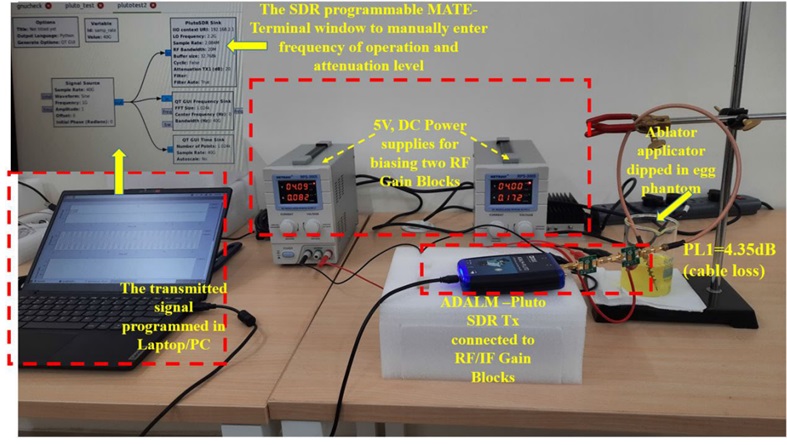Research Contributions
-
In our Laboratory for Innovation and Development on Antennas, Radars, and Electromagnetics (iDARE), we are developing solutions for applied electromagnetic (EM) problems which are relevant for
the next generation information and communication technology, security/defence, healthcare, and energy sector.
⚡ Contributions on Multi-functional Metasurfaces Featured in IISc Research Highlights
⚡ Contributions on MIMO Radar Featured in IISc Research Highlights
⚡ Coverage of Research on Full Duplex Antennas by IISc Press -
Our research philosophy attempts to strike a useful balance between three aspects: (a) design of various components (antennas, metasurfaces, circuit topologies),
(b) formulation of various computational algorithms and (c) system-level measurements on fabricated prototypes. The list of on-going/completed projects in our lab are as follows:
[6] Project Name: Metasurface based Beam-steering Antennas and Polarization Converters for mm-wave Satellite Communication
Role: Principal Investigator
Funding Agency: ISRO-IISc Space Technology Cell
Funding Amount: INR 22.11 Lakhs
Duration: 2024-2026, Status: On-going
[5] Project Details: TI Faculty Grant for Advising in Projects of two M.Tech. ECE Students selected in the "TI Scholar Program"
Role: Principal Investigator and Faculty Advisor
Funding Agency: Texas Instruments
Funding Amount: INR 4.00 Lakhs
Duration: 2024-2026, Status: On-going
[4] Project Name: Antenna Configurations and EM Theory for V2X Systems and Automotive MIMO Radars
Role: Principal Investigator
Funding Agency: DoT (Department of Telecommunication), India through SID (Society for Innovation and Development), IISc Bangalore
Funding Amount: INR 30.00 Lakhs
Duration: 2020-2022, Status: Completed
[3] Project Name: Design and Analysis of Modulated Space-Time Metasurfaces to Realize Nonreciprocal Microwave Circuits and Antennas for Future Communication Networks and Energy Harvesting Systems
Role: Principal Investigator
Funding Agency: SERB (Science and Engineering Research Board), DST, Govt. of India
Funding Amount: INR 26.18 Lakhs
Duration: 2022-2024, Status: Completed
[2] Project Name: Infosys Young Investigator Award
Role: Principal Investigator
Funding Agency: Infosys Foundation, Bengaluru, India
Funding Amount: INR 6.00 Lakhs (Unrestricted research grant besides top-up salary)
Duration: 2020-2022, Status: Completed
[1] Project Name: Institute Start-up Grant
Role: Principal Investigator
Funding Agency: Indian Institute of Science, Bangalore
Funding Amount: INR 78.00 Lakhs
Duration: 2020-2022, Status: Completed
Some major highlights of the research conducted so far in iDARE, ECE, IISc are presented below:
-
Research Highlight: Design and Analysis of Space-Time Modulated Metasurfaces
We are synthesizing space-time modulated metasurfaces having various functionalities like anomalous reflection, wireless channel modification (using RIS or reconfigurable intelligent surface), near-field excited beam-steering in antennas, WPT (wireless power transfer) imaging, EM-shielding and on-air mixing, RCS (Radar Cross Section) reduction, NLOS blockage mitigation etc.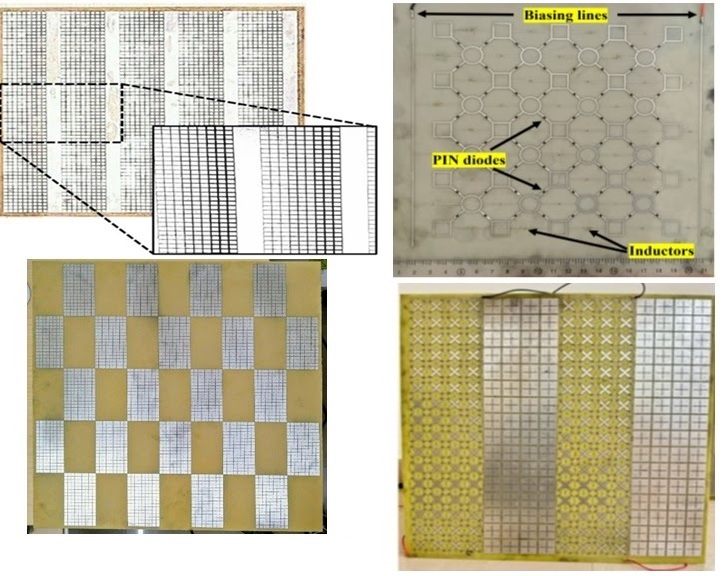

★ Multi-functional metasurface as a transmissive/reflective FSS and an on-air frequency mixer
★ A Multi-State Reconfigurable Intelligent Surface Based on Anomalous Reflectors for Communication and Radar Applications
★ Generation of High-Gain Steered Beam using Dipole Antenna Loaded on Anomalous Reflector with Near-field Correction
★ Coded Metasurfaces for Two Dimensional Steering and Splitting of Incident Radiation
★ Design of Anomalous Reflectors by Phase Gradient Unit Cell-Based Digitally Coded Metasurface
★ On the Aperture Size of Digitally Coded Metasurfaces for Beam Steering Applications using Anomalous Reflection -
Research Highlight: Antenna Design and EM Analysis of Integration Issues in MIMO Radar Systems
We are carrying out computational EM analysis of automotive MIMO Radars, both in terms of antenna design and vehicle integration aspects. Few modified binomially tapered series-fed microstrip patch arrays are proposed from his group for MIMO Radar applications. Furthermore, analysis of co-located MIMO Radar antennas after integration behind vehicle structures like bumpers are carried out using efficient computational electromagnetic techniques.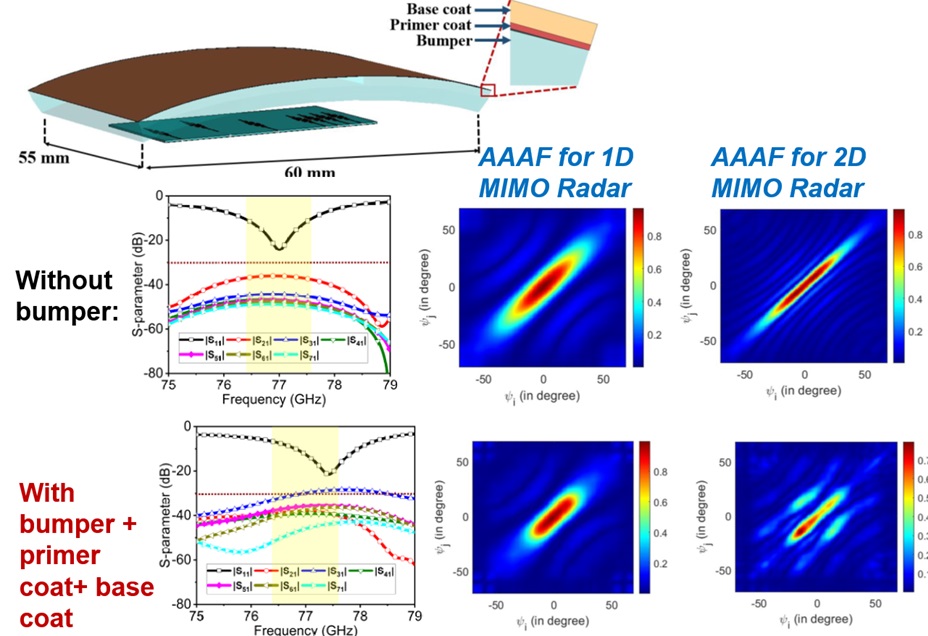
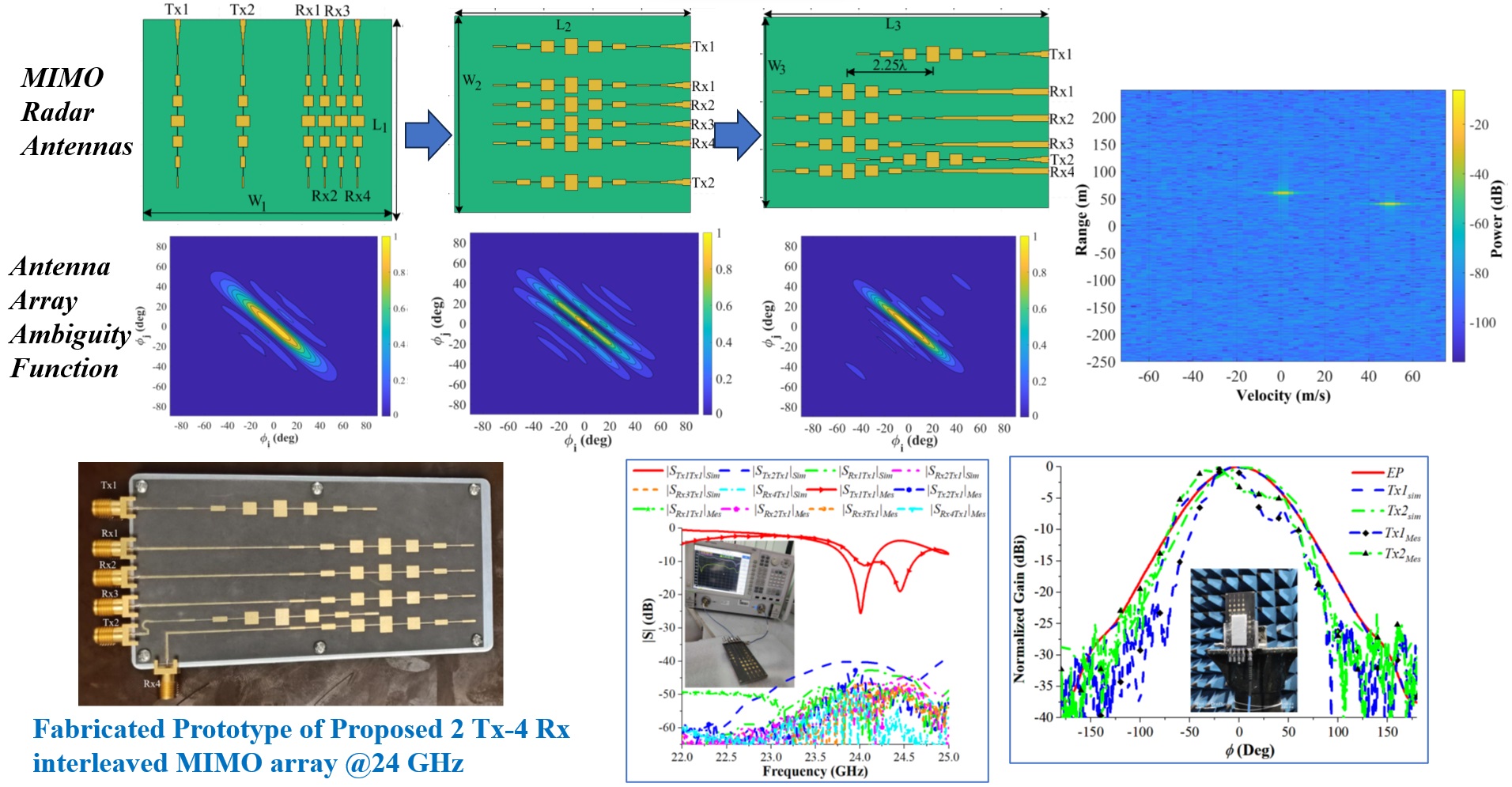
★ Compact MIMO Radar of Improved Angular Resolution Using Interleaved Array Geometry
★ Transparent Binomially Tapered Series-Fed Patch Array With Circular Polarization for Space Surveillance and Tracking MIMO Radar
★ Design of Series-Fed Antenna Array with Low SideLobe Level and Improved Azimuth Fied-of-View for Automotive RADAR Application
★ Antennas for mm-wave MIMO RADAR: Design and Integration Challenges for Automotive Application
★ Antenna Array Ambiguity Function Based Study of Integration Effect on a 2D Automotive MIMO RADAR Antenna Placed Behind a Painted Bumper
★ Design of a 2D MIMO Radar Antenna for 77 GHz Automotive Application
★ Effect of Painted Bumper on Automotive MIMO RADAR Performance Study Using Bi-directional Loss and Antenna Array Ambiguity Function
★ Design of Series-fed Patch Array with Modified Binomial Coefficients for MIMO Radar Application
★ Impacts on Automotive MIMO RADAR Performance due to Permittivity Variation of Bumper Material: Insights through Bi-directional Loss and Antenna Array Ambiguity Function -
Research Highlight: Antennas with Reduced Mutual Coupling for Full-Duplex Communication Systems
We are building collinearly polarized multi-port microstrip antennas for in-band full-duplex (FD) application, with unique techniques of antenna domain self-interference-cancellation (SIC) between Tx and Rx ports. All the proposed designs are initially designed for V2X (Vehicle to Everything)-ITS (Intelligent Transportation Systems) at sub-6 GHz (IEEE 802.11p) band, but can be scaled for other applications as well.
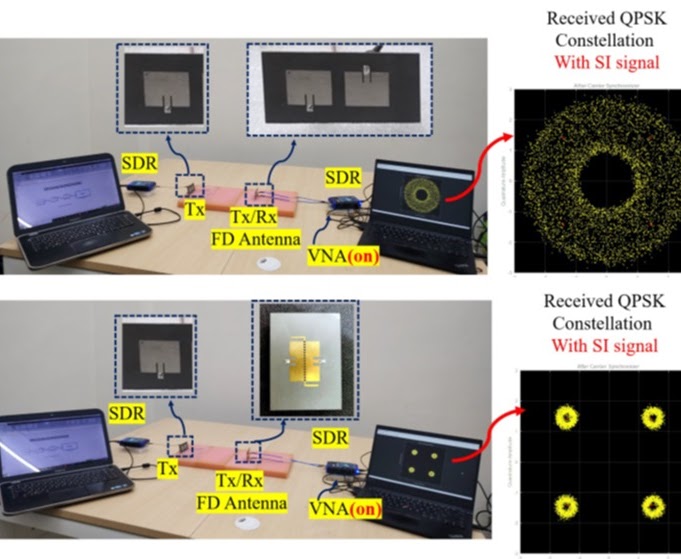
★ Experimental Demonstration of SI-Cancellation in a Co-Linearly Polarised Shared-Radiator Full-Duplex Antenna for 6G
★ A Co-Linearly Polarized Shared Radiator Based Full-Duplex Antenna with High Tx-Rx Isolation using Vias and Stub Loaded Resonator
★ A Co-Linearly Polarized Full-Duplex Antenna with Extremely High Tx-Rx Isolation
★ Microstrip Patch Antenna System with Enhanced Inter-Port Isolation for Full-duplex/MIMO Applications -
Research Highlight: Multi-band Antennas with Suppressed Higher Order Modes for Phased Arrays / MIMO Applications
We are building multi-band microstrip patch antennas using sub-wavelength resonator (e.g., CSRR or complementary split ring resonator) loading, and adopting new techniques for suppressing/reshaping the higher order modes. Such modified multi-band microstrip patch antennas bearing diverse polarization states can be used for building electrically large phased arrays or massive MIMO antenna architectures.
★ Dual-band dual-polarized sub-6 GHz phased array antenna with suppressed higher order modes
★ Mushroom Unit Cell Loaded Triple Band Microstrip Antenna for Sub-6 GHz MIMO and Phased Array Application
★ A CSRR Loaded Triple-Band Microstrip Patch Antenna with Suppressed Higher Order Modes for Sub-6 GHz Phased Array Application
★ On the CSRR Loaded Microstrip Patch Antennas: A Class of Metamaterial-inspired Radiators
★ A Four-Port CSRR-Loaded Dual-Band MIMO Antenna With Suppressed Higher Order Modes -
Research Highlight: FDTD Analysis of TVTLs (Time Varying Transmission Lines) and Non-Reciprocal RF Circuits
We are working on developing computational electromagnetic methods (particularly FDTD based approaches) for analyzing EM wave propagation in time-varying metamaterials and non-reciprocal RF circuits, where the frequency of temporal modulation is significantly high. Such systems can be practically realized by TVTLs (time-varying transmission lines) loaded with PIN/Varactor Diodes.
★ FDTD Modelling of RF Circuits Based on Lumped Components and Transmission Lines Using Modified Telegrapher's Equations
★ FDTD Analysis of Space-time Metamaterials using Modulated TVTLs for Frequency Translation, Mixing and Non-reciprocity
★ Computational Techniques for Design and Analysis of Time-Varying Capacitor Loaded Transmission Lines Using FDTD and Simulink
★ FDTD Analysis of Transmission Line Loaded with Time-Varying Shunt Capacitors for Mixer Applications
★ FDTD Analysis of Guided Electromagnetic Wave Interaction with Time-Modulated Dielectric Medium -
Research Highlight: Electromagnetic Analysis of Near-field Interactions in Electrically Large Multiple Antenna Systems
We are conceptualizing the use of EM Lagrangian density and Poynting vector magnitude to probe into the near-field region of multiple antenna systems in general (specifically electrically large massive MIMO arrays). These studies reveal interesting insights not readily available via traditional techniques like radiation quality factors of antennas.
★ Insights into the Near-Field Characteristics of mm-wave Massive MIMO Arrays using EM Lagrangian Density and Poynting Vector
★ Characterization of Reactive Energy Density in the Antenna Near-Field using EM Lagrangian Density
★ Antenna Mutual Coupling in Near-Field: Insights Using EM Lagrangian Density and Complex Helicity
★ FDTD Computation of Space/Time Integrated Electromagnetic Lagrangian: New Insights Into Design of Mutually Coupled Antennas
Presently available facilities
-
♦ Software: CST Microwave Studio + One Acceleration Token, Keysight ADS, MATLAB (Mathworks)
♦ RSA306 USB Real Time Spectrum Analyzer: Quantity = 1, Frequency range = 9 kHz to 6.2 GHz
♦ ADALM-PLUTO Active Learning Module (PlutoSDR): Quantity = 5, Frequency range = 325 to 3800 MHz, can be extended to 6 GHz
♦ Vector Network Analyzer 1: Quantity = 1, Keysight-N9950B, FieldFox 32 GHz Microwave Analyzer (Hand-held, Portable)
♦ Vector Network Analyzer 2: Quantity = 1, LibreVNA, Maximum Frequency = 6 GHz (Supported from AMPL)
♦ Vector Network Analyzer 3: Quantity = 1, NanoVNA, Maximum Frequency = 3 GHz
♦ Mini-Circuits’ ZHL-4240+ Coaxial Amplifier (Medium High power): Quantity = 1, Frequency range = 600 to 4200 MHz
♦ Gain Blocks ADL5610: Quantity = 2, Frequency range = 30 MHz to 6 GHz
Additionally, the following facilities and components are present: (i) Mechanical Toolkit and Drilling Machine, (ii) In-house Body Mimicking Gel Preparation Facility, (iii) DC Sources, Cables, Connectors for Sub-6 GHz as well as mm-wave, attenuators, (iv) Soldering Station. We ensure full compliance with the safety requirements while using the hardware and facilities as mentioned above.
Furthermore, we use MATLAB (Mathworks) and its various toolboxes (RF Toolbox, Antenna toolbox etc) for doing analytical studies and computational analysis of antennas and circuits operating in Radio Frequencies. For the fabrication of PCB Fabrication with smooth finish, we rely on local vendors.
Some additional snapshots of experiments being conducted in iDARE Laboratory, ECE, IISc (besides the ones included in the research highlights section) are as follows:
E1. Wireless power transfer into Implanted Antennas:

E2. SAR Measurement in Tissues using Catheter Antenna:
